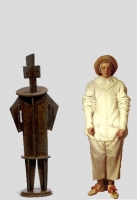26 Mar 2015
Ssh! The Secret of Picasso’s Ear
Ears make sense as one of the five: touch, taste, sight, sound and smell. But who thinks about Picasso's ears? We mostly remember his eyes: deep, dark and powerful. Yet he himself - as I don't think has been noted before - seems to have been very
11 Jan 2015
Hans Memling and Cubism
Every time I look at this Portrait of a Man by Hans Memling I feel a little sick. I’m serious. It makes me slightly nauseous. Perhaps Walter Pater, the 19th-century art historian, felt similarly about the Mona Lisa. He described her as a weirdo
13 Mar 2014
Flat Noses on a Frontal Face
A year ago I used this early portrait drawing by Ingres (left) to demonstrate that Picasso's combination of faces from differing viewpoints, a hallmark of Cubism, was a technique practiced by earlier artists for a similar reason. Ingres, for ins
25 Jan 2013 | 3 Comments
Picasso’s Unseen Portrait at the Metropolitan Museum
I was going to write about how the objects most frequently depicted by the Cubists in their café still-lifes – pipe, bottle, glass and guitar – were used not primarily as items characteristic of café-life as Rosalind Kr
17 Nov 2012
Mental images from Holbein, Ingres and Picasso
It is well-known that Picasso admired Ingres' portrait drawings like the one above on the left. Separately I have shown how Ingres, like other great masters, changed the facial features of his sitters to fuse them with his own. Not all portraits
07 Nov 2012
Jacques Lipchitz as a Jewish Christ
Jacques Lipchitz (1891-1973) was mostly a follower of his period's more innovative artists but that does not mean that he lacked the visual perception to make sense of art. He had that in spades. The bronze, above left, of a Pierrot, a well-
30 Oct 2011 | 2 Comments
Cubism Explained
No-one, to my mind, has ever satisfactorily explained Cubism. Indeed I have found the explanations and their complexity totally confusing. Roland Penrose, a close friend of Picasso, claimed that Cubist images try:
‘to state t
The EPPH Blog features issues and commentary.







